Meeting Highlights
AAPT 2008 Summer Meeting-Edmonton, Alberta
July 19-23, 2008
A message from Alexander K. Dickison
Program Chair and President Elect
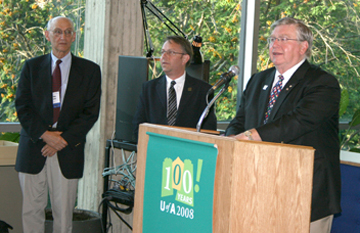 |
| Chancellor Eric Newell welcomes AAPT to the University Centenary. With him are E.O. Charles Holbrow (l) and Alberta Section V.P. Brent McDonough (c). |
A week before the AAPT meeting the PTRA Institute was held. Approximately eighty Physics Teaching Resource Agents (PTRA) spent the week exchanging ideas and attending workshops. The PTRA program began in 1985 and has remained a vital, important program to AAPT.
Starting on the Friday before the meeting and running for two days was the PhysTEC. (Physics Teacher Education Coalition) PhysTEC is a program with a mission to improve physics and physical science teacher preparation. What an important mission to AAPT.
At the end of the AAPT meeting starting on Wednesday afternoon was the Physics Education Research Conference (PERC). It ran through Thursday. The theme was “Physics Education Research with Diverse Student Populations.” There were invited talks, workshops, poster sessions, and roundtable discussions. There will be a PERC Proceedings available on line.
Workshops and Field Trips
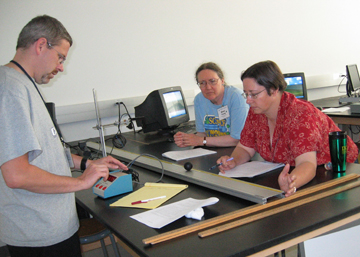 |
| Douglas Forrest, Anne Young, and Jennifer Kirkey tested a plausible-but-wrong theory in the Falsification Labs workshop organized by Eric Ayars and Tim Ericson. |
In addition to the workshops there were two field trips on Sunday. The University of Alberta is the home of Canada's NRC National Institute for Nanotechnology. Sunday afternoon they opened their doors for three tours of their facilities. It was interesting and well attended. The second field trip was to the Riverdale Net Zero House. This house generates as much electricity and heat as it consumes over the course of a year making its net annual energy use zero! This is in Edmonton, Alberta, Canada. Visit their website and learn more at: www.riverdale.netzero.ca.
Paper Sessions
The area committees are responsible for sponsoring and organizing the sessions at the National Meetings. There are 18 AAPT area committees, each representing a different interest or specialty in physics education. The area committees did an outstanding job planning for the Edmonton meeting. The sessions reflected the varied interests of AAPT members.
Sessions addressing graduate education, upper level undergraduate courses and laboratories, introductory college physics, and high school physics were popular and well attended. The Physics Education Research Community had a number of outstanding sessions, and the rooms were filled. It is always difficult deciding what sessions to attend at a National Meeting. There are so many interesting sessions running concurrently. Besides the session topics already mentioned, there were sessions on teacher preparation, demonstrations, laboratories, teaching technology, International Physics Education, and the history of physics.
Undergraduate students had the opportunity to present at the National Meeting in both a poster session on Sunday, and a paper session on Monday. These sessions were organized by the Society of Physics Students. It was good to see the enthusiasm of these students and the quality work they had done.
An important part of any National Meeting are the sessions that explain the current developments in astronomy and physics research. The theme for the Edmonton meeting was “Physics from the Ground Up.” In keeping with this theme there were sessions on Geophysics, Alternative Energy, Seeing the Universe without Our Eyes, and Canadian Women in Science. All of these were top notch.
Award and Plenary Sessions
On Monday, Michio Kaku received the Klopsteg Memorial Award. This award honors extraordinary accomplishments in communicating the excitement of physics to the general public. Professor Kaku gave an informative and entertaining presentation entitled “Physics of the Impossible.” He pointed out that one hundred years ago scientists thought that lasers, television, and visiting outer space were impossible. We now know these were achieved. He then introduced a number of ideas that we now consider impossible. Using science, he explained if these ideas could actually become possible in the future. This talk was based on his most recent book Physics of the Impossible: A Scientific Exploration of the World of Phasers, Force Fields, Teleportation, and Time Travel.
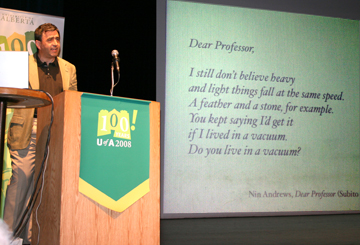 |
| Eric Mazur: Physicists' "reality" is often not students' "reality." |
Mazur showed a diagram of a runner dropping a ball and asked the audience which best described the path of the ball: (a) fall behind the runner; (b) fall straight down; or (c) fall along a forward arc? As experienced physics teachers, we all chose (c). In video interviews, passers-by on Harvard Square all chose (b). In video interviews in their offices Harvard physics professors all chose (c). Mazur then showed a video of a runner dropping a ball. It fell almost straight down. All the professionals were wrong; all the naive persons-in-the-street were right. Mazur pointed out that for the forward arc to be right, the runner would have to run faster than 25 mph. No wonder students find confusing the diagrams and concepts that appear in physics textbooks. More than entertaining, Mazur’s talk raised important issues about the artificiality of introductory physics.
During Wednesday’s Award Ceremony Corinne Manogue, Oregon State University, was awarded the Excellence in Undergraduate Physics Teaching Award. Her talk,“The View from the Other Side of the Mountain: Exploring the Middle Division,” explained the complete curriculum revision for physics majors that took place at Oregon State University.
Mark Davids, Grosse Pointe South High School, received the Excellence in Pre-College Physics Teaching Award. His lively talk, “Best Practices,” discussed the best practices that teachers can use to influence their students.
Jack Hehn presented the AIP Science Writing Award in the Broadcast Media Category to Bob McDonald, Pat Senson, and Jim Handman for “Quirks and Quarks” the popular Canadian science show on CBC radio.
AAPT Distinguished Service Citations went to Dean Baird, Rio Americano High School; Anne Cox, Eckerd College; Harry Manos, Los Angeles City College; Karen Jo Matsler, Education, Assessment and Training, Inc. and Dallas Baptist University; Steve Shropshire, Idaho State University; and Richard Zitto, Youngstown State University.
There were three excellent plenary sessions. The first plenary was given on Monday by Damian Pope, Perimeter Institute for Theoretical Physics, Waterloo, Ontario, and was titled “Teaching Dark Matter to High School Students.” This presentation was an easy to understand explanation of the argument for the existence of Dark Matter. As a special gift, free copies of the DVD, “The Mystery of Dark Matter” produced by the Perimeter Institute were given to everyone in the audience.
The second plenary was given on Tuesday by Robert Wolkow, National Institute for Nanotechnology, University of Alberta. The talk was titled “The Ruse and the Reality of Nanotechnology.” This talk gave a summary of where nanotechnology is now and what the future will probably hold. Important explanations of some misconceptions that have been popularized about the future were given.
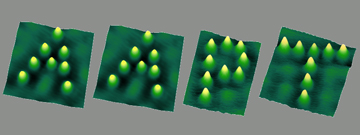 |
| Mark Freeman closed his talk with a tribute to AAPT—spelled out in letters formed with single CO molecules ("Times New Monoxide" he called it ) on Cu(111), courtesy of Jacob Burgess and David Fortin, Department of Physics, University of Alberta. |
Contests, Vendors, and Special Events
Twenty-five vendors displayed their products, and PASCO sponsored the Cyber Café in the vendors’ area.Near the Registration area was the Two Year College Resource Room. Next to it was the PIRA Resource Room, which is always a hit. In the same room was the Apparatus Competition with prizes sponsored by PASCO.
The photo contest is growing in popularity and in the quality of the entries. Mary Winn coordinated this contest, and Vernier sponsored the prizes.
The traditional picnic was held on Tuesday evening. It was the only rainy day during the entire meeting, and so it was decided to move the picnic indoors which did not seem to diminish the spirit of the evening. After the picnic was the traditional Demonstration Show, and what a show it was!! The show was organized by Stanley Micklavzina from the University of Oregon and in combination with the PIRA group has set a standard that will be hard to top.
Recognition
A National Meeting does not take place without a great deal of work. The University of Alberta welcomed us with open arms. We had the support of John Beamish, Physics Department Chair and the entire Physics Department. The Director of Undergraduate Laboratories, Isaac Isaac deserves a thank you for all the support and help he gave. AAPT Alberta Section president Vlad Pasek and vice president Brent McDonough and other local volunteers were enormously helpful.
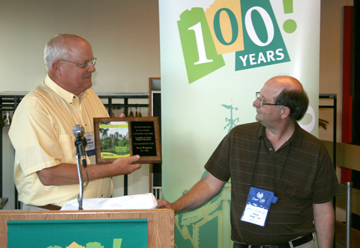 |
| Alex Dickison congratulates Terry Singleton on a job well done. |
Before the meeting a paper sort was necessary. The paper sorters were David Cook, Shannon Mandel, Rachel Scherr, and Terry Singleton. They deserve a special thank you.
Finally, I want to recognize the work the entire staff at the Central Office does to make a National Meeting successful. Every member of the staff in College Park, one way or another, contributes to the National Meeting. For most of the 40 years I have been a member, I took all of this for granted, but from now on I will realize what a tremendous job this is.
My term as Program Chair, during my travel through the Presidential chain, is fast coming to a close. My wife often asks me why I enjoy working for AAPT so much. One big reason this past year has been working with Natasha Randall, Janet Lane, and Tiffany Hayes. They are truly professionals who make a neophyte like me look good. Thank you!!

